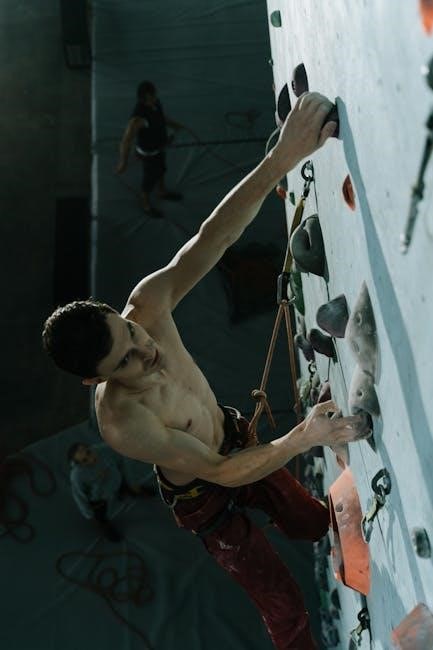Reciprocal Imitation Training (RIT) is a naturalistic, evidence-based intervention helping young children with autism through play-based imitation, enhancing social skills and engagement while promoting spontaneous interaction.
1.1 Overview of RIT and Its Importance
Reciprocal Imitation Training (RIT) is a naturalistic, evidence-based intervention designed to enhance imitation skills in children with autism through playful, child-led interactions; By focusing on mutual engagement, RIT fosters spontaneous imitation and social interaction, addressing a core challenge in autism. This approach is structured to be parent- or therapist-led, emphasizing the importance of reciprocity, where the adult imitates the child’s actions and vocalizations to encourage mimicry. RIT’s adaptability makes it accessible for various developmental levels, promoting meaningful connections and skill generalization. Its significance lies in its ability to bridge developmental gaps, offering a foundational tool for improving social communication and engagement. Research supports RIT’s effectiveness in enhancing both elicited and spontaneous imitation, making it a valuable intervention in early autism support.
1.2 Historical Development of RIT
Reciprocal Imitation Training (RIT) emerged as a naturalistic intervention for autism, rooted in developmental and behavioral research. Initially developed to address imitation deficits, RIT drew from studies showing that children with autism benefit from adult imitation during play. Early research by Brooke Ingersoll and colleagues in the 2010s laid the groundwork, demonstrating RIT’s effectiveness in teaching spontaneous imitation. The approach evolved from traditional behavioral techniques, incorporating a more child-centered, play-based methodology. Over time, RIT gained recognition as an evidence-based practice, supported by randomized controlled trials highlighting its impact on both elicited and spontaneous imitation skills. Its development reflects a growing emphasis on naturalistic, family-friendly interventions that foster social engagement and developmental progress in young children with autism.
Core Principles of Reciprocal Imitation Training
Reciprocal Imitation Training (RIT) focuses on mutual imitation, play-based learning, and naturalistic interactions to foster social and developmental skills in children with autism.
2.1 The Role of Imitation in Learning and Development
Imitation is a fundamental mechanism in learning and development, enabling children to acquire new skills, understand social behaviors, and develop language. It allows them to observe, replicate, and internalize actions and behaviors, fostering cognitive and social growth. For children with autism, imitation can be particularly challenging, making it a critical target for intervention. RIT leverages this natural process by encouraging reciprocal interactions, where both the child and the therapist imitate each other, creating a dynamic and engaging learning environment. This mutual exchange not only enhances imitation abilities but also promotes spontaneity and generalization of skills. By embedding imitation within playful and meaningful contexts, RIT supports the development of essential life skills and social competencies, making it a powerful tool for fostering overall development in children with autism.
2.2 Key Components of RIT
Reciprocal Imitation Training (RIT) is built on several core components that make it effective. First, it emphasizes mutual imitation, where both the child and the therapist imitate each other, creating a reciprocal and engaging interaction. This approach fosters spontaneity and encourages the child to take the lead. Second, RIT incorporates naturalistic teaching techniques, such as following the child’s interests and using play-based activities to promote learning. Third, it relies on reinforcement strategies to encourage and maintain imitation behaviors. Additionally, RIT focuses on generalization, ensuring that skills learned during sessions are applied in various settings. These components work together to create a dynamic and child-centered intervention that promotes imitation, social engagement, and overall development in children with autism.
Benefits of Reciprocal Imitation Training
RIT enhances imitation skills, improves social interactions, and boosts engagement in children with autism, fostering spontaneous behaviors and meaningful connections through play-based, naturalistic approaches.
3.1 Enhanced Imitation Skills in Children with Autism
Reciprocal Imitation Training (RIT) significantly improves imitation skills in children with autism by encouraging spontaneous and generalized imitation. Through naturalistic, play-based interactions, RIT teaches children to imitate gestures, actions, and vocalizations, fostering developmental growth. The intervention focuses on reciprocal exchanges, where the child and therapist take turns imitating each other, creating a dynamic and engaging learning environment. Research shows that RIT effectively enhances both object and gesture imitation, leading to more natural and spontaneous behaviors. By promoting these foundational skills, RIT not only strengthens imitation abilities but also lays the groundwork for improved social interaction and communication. The approach is tailored to the child’s interests, ensuring meaningful and enjoyable learning experiences that encourage long-term skill development and adaptability in various social contexts.
3.2 Improved Social Interaction and Engagement
Reciprocal Imitation Training (RIT) fosters improved social interaction and engagement by encouraging meaningful exchanges between children and their caregivers or therapists. Through playful, reciprocal exchanges, children learn to initiate and respond to social cues, enhancing their ability to connect with others. RIT’s focus on shared activities and mutual engagement helps children develop essential social skills, such as turn-taking, eye contact, and shared attention. These interactions not only strengthen relationships but also reduce autistic-like behaviors. By embedding imitation within natural play, RIT creates opportunities for children to practice and generalize social behaviors in real-world contexts. Over time, this leads to increased confidence, more spontaneous interactions, and greater participation in peer and family activities, ultimately improving overall social functioning and quality of life for children with autism.

Training Methods and Strategies
RIT employs parent-child interaction techniques, structured play activities, and caregiver support to encourage spontaneous imitation and meaningful engagement in children with autism effectively.

4.1 Naturalistic Teaching Techniques
Naturalistic teaching techniques in RIT emphasize learning through play and daily routines, creating a supportive environment where children with autism can naturally imitate and engage with others. These methods focus on child-led activities, allowing therapists or caregivers to follow the child’s interests and incorporate imitation opportunities seamlessly; By blending instruction with play, RIT ensures that learning is both enjoyable and meaningful. This approach also encourages spontaneous interaction, helping children generalize imitation skills across various settings. The use of naturalistic techniques makes RIT adaptable to different learning styles and environments, enhancing its effectiveness in fostering social and imitation abilities in young children with autism. This method is widely recognized for its ability to promote engagement and long-term skill development.
4.2 Incorporating Play-Based Learning
Play-based learning is a cornerstone of RIT, leveraging children’s natural inclination to engage in play to teach imitation skills. By integrating playful activities, RIT creates opportunities for spontaneous and generalized imitation, making learning fun and effective. Play serves as a medium to capture the child’s interest, allowing therapists and caregivers to model actions and encourage mimicry. This approach not only enhances imitation abilities but also strengthens social interaction and engagement. Play-based learning in RIT is flexible, adapting to the child’s preferences and developmental level, ensuring that each session is both enjoyable and productive. The emphasis on play aligns with the child’s intrinsic motivation, fostering a sense of autonomy and creativity while learning essential skills. This method is particularly effective for children with autism, as it capitalizes on their unique interests and strengths. Through play, RIT bridges the gap between structured therapy and natural, everyday interactions, promoting long-term skill development and adaptation across various environments.

Implementing RIT in Daily Practice
RIT integrates naturally into daily routines, engaging caregivers and therapists in playful, spontaneous interactions that foster imitation and social connection, supporting consistent skill development in children with autism.
5.1 When to Use RIT
Reciprocal Imitation Training (RIT) is most effective when used with young children with autism during early developmental stages, particularly when improving social and imitation skills is a priority. It is ideal for children who struggle with spontaneous imitation, as it fosters natural, interactive learning through play. RIT is recommended when a child exhibits limited engagement in social activities or when imitation skills are emerging but require support. It is also suitable for children with varying levels of language development, as it adapts to individual needs. RIT should be implemented consistently, ideally in combination with other evidence-based interventions, to maximize its benefits. By integrating RIT into daily routines, caregivers and therapists can create meaningful opportunities for skill development in a naturalistic, child-led environment.
5.2 How to Apply RIT Effectively
To apply RIT effectively, start by identifying the child’s interests and incorporating them into play-based activities. Use naturalistic teaching techniques, such as imitation and reciprocity, to create engaging interactions. Ensure the child has frequent opportunities to imitate actions or gestures, and immediately reinforce their attempts with positive feedback. Maintain a balance between initiating and following the child’s lead to foster spontaneous imitation. Provide clear, immediate feedback and be patient, allowing the child time to process and respond. Consistency is key; integrate RIT into daily routines and involve caregivers and therapists in the process. By creating a supportive and interactive environment, RIT can effectively promote social and imitation skills in children with autism.
Case Studies and Real-World Applications

RIT case studies demonstrate its effectiveness in enhancing social interaction and spontaneity in children with autism through evidence-based, naturalistic play-based interventions.
6.1 Successful Outcomes of RIT
Studies demonstrate that RIT significantly improves imitation skills in children with autism, fostering spontaneous and generalized imitation. Through play-based interactions, RIT enhances social engagement and interaction skills, promoting meaningful connections. Research highlights increased spontaneity in gestures and vocalizations, with positive outcomes in naturalistic settings. Children show improved object and gesture imitation abilities, leading to better communication and play skills. These outcomes are supported by randomized controlled trials and case studies, underscoring RIT’s effectiveness as a naturalistic developmental intervention. The structured yet flexible approach of RIT allows for tailored interventions, making it adaptable to various developmental needs. Overall, RIT has proven to be a valuable tool in supporting children with autism, leading to long-term social and developmental benefits.
6.2 Challenges and Solutions in RIT Implementation
Implementing RIT can present challenges, such as the need for consistent and skilled facilitation by caregivers or therapists. One common issue is ensuring the child’s engagement and motivation during sessions. To address this, incorporating the child’s interests and preferences into play-based activities is essential. Another challenge is the time and effort required to train parents and caregivers effectively. Providing structured training programs and ongoing support can help overcome this barrier. Additionally, generalizing imitation skills to diverse settings can be difficult; integrating RIT into daily routines and multiple environments is key. Finally, some children may initially resist interactive play, requiring patient and gradual introduction of RIT strategies. Despite these challenges, RIT’s flexible and naturalistic approach allows for tailored solutions, making it a viable intervention for many families and professionals.

Future Directions in Reciprocal Imitation Training
Future directions for RIT include expanding its application to diverse populations and exploring its long-term effects on social development. Research could investigate the integration of RIT with other therapies, such as speech therapy, to enhance comprehensive developmental outcomes. Technological advancements, like virtual reality or interactive apps, could also be explored to make RIT more accessible and engaging. Additionally, there is potential to adapt RIT for use in different cultural contexts, ensuring its effectiveness across varied societal norms and practices. Training more professionals and caregivers in RIT implementation could further increase its reach and impact. Lastly, studying the neural mechanisms behind RIT’s success could provide deeper insights into its efficacy, paving the way for refined and evidence-based practices.
